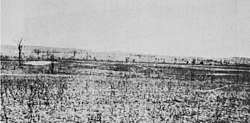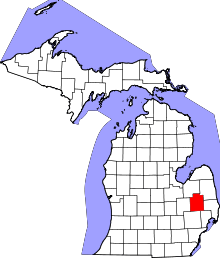Younge Site
|
Younge Site (20LP3) | |
 Younge Site, c. 1936 | |
 Location of Goodland Township, Michigan  Younge Site (the US) | |
| Location | Goodland Township, Michigan[1] |
|---|---|
| Coordinates | 43°08′40″N 83°03′30″W / 43.14444°N 83.05833°WCoordinates: 43°08′40″N 83°03′30″W / 43.14444°N 83.05833°W |
| NRHP reference # | 76002161[2] |
| Significant dates | |
| Added to NRHP | October 29, 1976 |
| Designated MSHS | October 29, 1971[3] |
The Younge Site is an archeological site located within the vicinity of Goodland Township in Lapeer County, Michigan. It was designated as a Michigan State Historic Site on October 29, 1971 and later added to the National Register of Historic Places on October 29, 1976.[2][3]
Description

The Younge Site is located on a level plain about a mile wide, near a stream. The site itself spans about three acres, and contains remnants of two separate occupations. The remains of two enclosures were found, each made from poles set into the ground. One was about 585 feet long and 25-30 feet wide. The second was 252 feet long and 25 to 30 feet wide. [4]
The first of the enclosures also contained a number of burials, with at least 82 individuals represented. A number of pottery fragments were found at the site, along with tobacco pipes and a few stone and bone implements.[4]
History
A preliminary excavation of the site was completed in 1934 by W. B. Hinsdale. This proved promising, and more extensive excavations were completed the next year by Emerson Greenman of the University of Michigan.[4]
The Younge Site is a pre-Columbian era site located in the east-central part of Lapeer County. There were no European objects discovered on the site, but there are two wooden structures and a burial site presumed to belong to Native Americans around the same time the Europeans arrived in the area in the seventeenth-century. Archaeologists discovered unusual burying practices in the exhumed remains, including the drilling of the skulls prior to being buried. The leg bones were also modified to support the body when suspended from a pole in an ossuary, which was observed—although not firsthand—in the accounts of the earliest European settlers.[5]
References
- ↑ The NRIS lists the Younge Site as "Address Restricted," but Greenman shows the rough location. Geo-Coordinates are approximate.
- 1 2 "National Register Information System". National Register of Historic Places. National Park Service. July 4, 2011.
- 1 2 State of Michigan (2009). "Younge Site (20LP3)". Retrieved August 9, 2011.
- 1 2 3 Greenman, Emerson (1967). The Younge site: An archaeological record from Michigan. Ann Arbor: University of Michigan Museum of Anthropology.
- ↑ Michelson, Truman. "Book Reviews: The Younge Site: An Archaeological Record from Michigan". doi:10.1525/aa.1938.40.3.02a00090.
| Wikimedia Commons has media related to Younge Site. |
